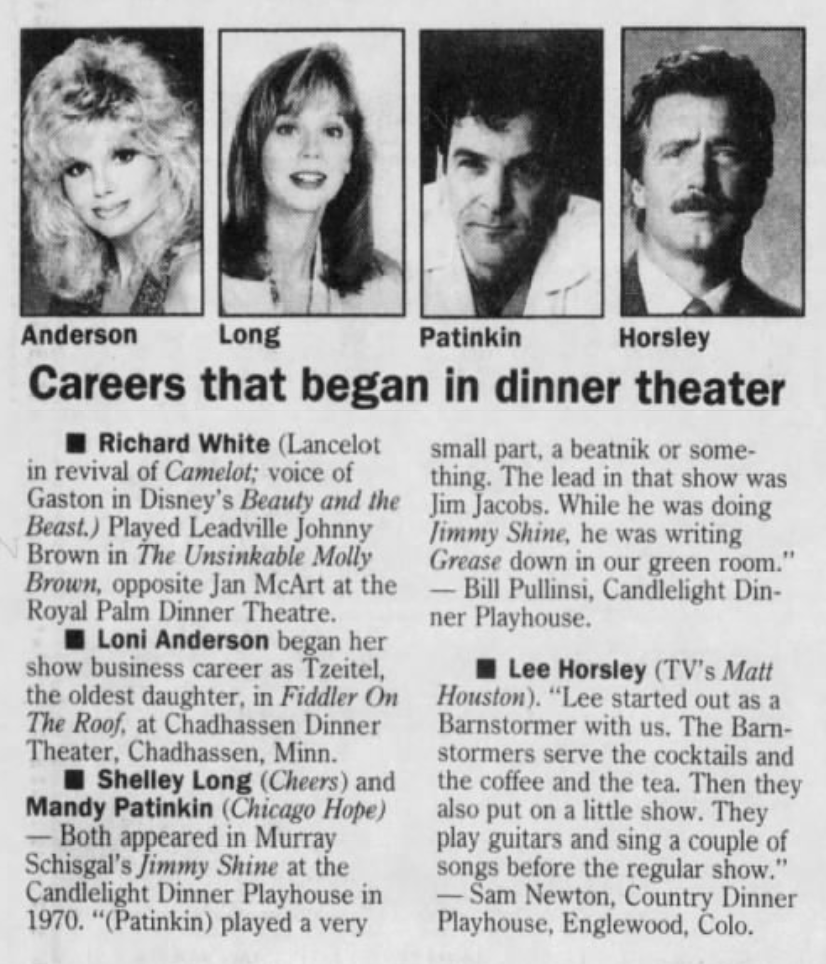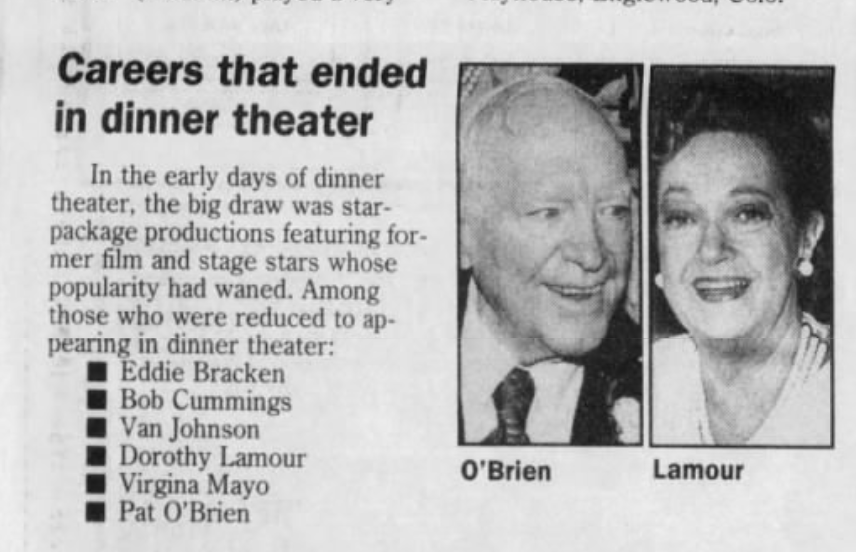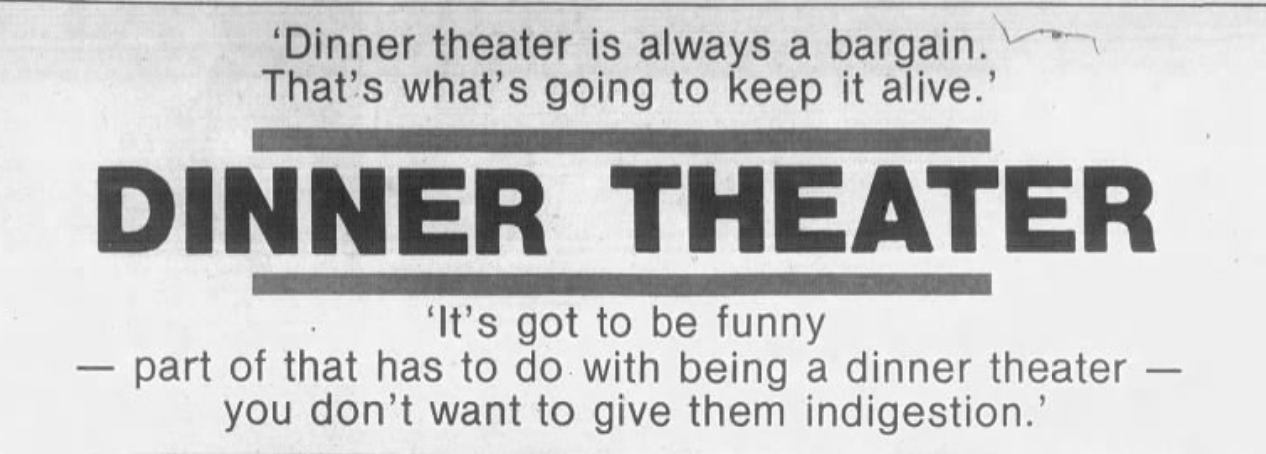Dinner & a Show: How the Curtains Have Opened and Closed on America’s Dinner Theaters
by Julianna Drew Björkstén
![]()
I spent my childhood in middle America, in a small, lazy town like so many others that crisscross the bloated belly of the country—the kind of place populated by generations of ranchers, oil field workers, and schoolteachers. I grew up in a family of theatre enthusiasts, and with no Broadway or off-broadway or off-off broadway nearby, we attended what was available in our culture-starved community: dinner theatre. Every July, my family would pile into the minivan and drive five hours to Jackson Hole, Wyoming. After a week of biking along Jenny Lake, hiking steep mountain trails, and whitewater rafting down the Snake River, we would finish off the trip with an all-American dinner and a show.
For the uninitiated, dinner theatre —“the land of roast beef au jus and greasepaint” — is an entertainment experience that includes both a theatrical performance and a restaurant meal, usually at the same venue, and often with the actors doubling as waiters. At dinner theaters, audiences are offered buffet-style food, farcical comedies, and extensive drink menus.
Every year in Jackson Hole, my family witnessed the talents of a singing cowboy troupe, the Bar J. Wranglers, while chowing down on chuckwagon ribs. When we were lucky, we would go to the Jackson Hole Playhouse, where we would gulp sarsaparilla and eat up performances of Footloose or Annie Get Your Gun.
Visiting my grandparents in South Carolina, we went to a show by the theatre franchise Medieval Times Dinner and Tournament, where we jeered at jousting knights and gnawed on greasy chicken legs. And when one of the directors at my local children’s theater landed a role at the Candlelight Dinner Playhouse in Colorado, we all went to see her in Seven Brides for Seven Brothers, a staple on the dinner theater menu.
You could say I’ve dabbled in dinner theatre patronage. As a kid, I always enjoyed myself at these shows. Food and entertainment in one sitting seemed like an obvious pair (see, Netflix and takeout); it wasn’t until I moved to New York that I became aware of the distaste, ridicule, and upturned noses that dinner theatre is often met with. Critics, urbanites, and theatre snobs scoff at culinary theatre, which offers affordable and convenient entertainment for middle and working-class Americans. The consensus seems to be that this sort of dining-entertainment is tasteless and low-class. As someone whose childhood was zested by dinner and a show, but who hasn’t looked critically at it as an adult, it bears asking: Is there any merit to these criticisms, or are they born out of classist snobbery? What is the value of dinner theatre and how has it been valued historically?
Dinner theatre has changed and diversified over the years. It’s always been affordable and accessible, but in many places its humble origins have been discarded for flashier spectacles and specialty theaters. It’s common now to see interactive murder-mysteries, plotless burlesques, and medieval knights in an arena, like the one I saw as a child. The essential feature (and draw) of dinner theatre, however, has remained unchanged since it started: a cheap dinner and show under the same roof.
In the 1950s, tableside theatre began as an affordable way for middle America to have a night out—to see a show and eat out for one low price. Some of the earliest dinner theaters took place in remodeled country barns, with chuckwagon-style meals and performances by local thespians. There is some dispute about which dinner theater was the first: Some candidates include The Meadowbrook in New Jersey, Barksdale Theatre in Virginia, and Candlelight Dinner Playhouse in Chicago. Regardless, dinner and a show didn’t really take off until the 1960s, when suburbs were expanding rapidly and urban crime rates were rising. By the ‘70s, dinner theaters employed more professional actors than any other area of theatre. It didn’t last, though: By the ‘90s the glory days of dinner theatre were in the past.
Although culinary theatre has been the butt of jokes since its curtains first opened , it was still quite successful well into the twentieth century. In the late ‘60s and ‘70s, the heyday of dinner theaters, there were about 150 theaters in operation, and the industry was valued at $150 million. By then, dinner theatres had upgraded their talent, too, from whatever actors were at hand to professional performers from major cities. As a dinner theatre patron in that era, you were likely to see lots of student actors but also film and TV celebrities like Esther Rolle, Joey Bishop, and Mickey Rooney (though plenty of professional actors stuck their nose up at the idea of performing tableside as well). Well-known actors began their professional careers at dinner theater, and acclaimed performers stuck around. This was due, in part, to the aggressively competitive professional industry at the time. As one Tony Award-winning actor put it, “The reason I'm playing dinner theaters is that I can't find work on Broadway.”


This sentiment was pervasive in the industry. Critics and actors alike decried the death of the theatrical arts, practically calling dinner theatres sacrilege. (To be fair, chuckwagon-style meals and lighthearted musicals aren’t exactly pillars of high-society.) On the other hand, financial desperation and quixotic capitalism were also pervasive. Writing on dinner theaters in 1973, a New York Times critic remarked: “There is no question but that their emergence constitutes an entirely novel, and highly lucrative, theatrical phenomenon.” This turned out to be less than true, with most dinner theaters closing by the 1990s, but at the time, the industry seemed promising, grounded in “predictable economics,” with pre-booked tables and an immutable menu. In reality, owning a dinner theater involved dealing with “two very chancey businesses:” live theatre and food service. On top of that, audiences expected the prices to be very low. Many theaters closed down or barely scraped by (on liquor sales), exploiting their actors and sacrificing the quality of their food in the process. The industry developed a reputation for “no surprises, either on the plate or on the stage.” Culinary theatre became synonymous with middling, flavorless food. Reviewing a dinner theatre meal, one critic wrote, “The steak was tough, the mixed vegetables were cold, and the fish was like something out of a TV dinner.”
Largely, though, the safe and unsurprising quality of dinner theatre was appealing to patrons. In the crime-ridden 1970s, dinner theaters, with their “neon-lit” parking lots, were a safe option for a night out. Safe was also used to describe the performances themselves. Dinner theaters were, and still are, notorious for putting on “light, frothy, Chantilly lace” shows, and skirting anything controversial or psychological. They cycled through the same tried-and-true musicals, aiming for the patrons to “walk out humming the songs.” When the economy plummeted in the 1980s, upbeat comedy shows became even more in demand. Asked about this for a newspaper article, a dinner theater manager quipped, “The worse the economy gets, the funnier the show has to be.”

Not everyone, however, was impressed by these frivolous productions. After seeing a standard dinner theatre show, a critic described it as “pleasant, light, funny, but nothing to sink your teeth into.” The newspapers depicted dinner theatre as tacky, trite, and “little more than live television.” Performances were conventional, meals were bland, and the theaters themselves were “pseudo-grand,” located off the side of the highway. While some of these negative assessments seem warranted, others unfairly take aim at the audience rather than the playhouses, ridiculing them for their class and tastes. Sneeringly, one critic remarked, “The audience is the same audience that watches television.”
When the pandemic hit last year, restaurants and theaters took it hard. In a New York Times article from the end of the year, a culture columnist predicted dinner theaters, which were already teetering, would face a “particularly grim prognosis.” Many dinner playhouses, including the famous Westchester Broadway Theater, closed down permanently in 2020. Surprisingly, though, most of the biggest dinner theaters in the country have survived the pandemic, and several are opening back up this summer. The Jackson Dinner Playhouse, whose shows I attended in my childhood summers, has even been able to continue staging performances during the pandemic. In three weeks, they’re opening their summer show, Seven Brides for Seven Brothers.
Dinner theaters may have fared so well during the past year because of their dual status as restaurants and playhouses. Like the Jackson Dinner Playhouse, the Candlelight Dinner Playhouse in Colorado was able to re-open just a few months into the pandemic. This was possible because, unlike traditional theaters with rows of seats crammed side-by-side, culinary theaters fall under “restaurant seating” guidelines. What’s more, dinner theaters are typically found in more suburban and rural counties, where COVID-19 restrictions haven’t been as imposing.
Pat Payne, the production manager at the Candlelight Dinner Playhouse, joked, “We’re the dinner theater in the middle of a cornfield...The reality is, that’s what saved us.”
The Candlelight did have to make significant changes to stay open, though. To comply with the six-foot rule, the tables are so spaced out you could “fit a truck between them.” The actors can no longer double as waiters, something that is quintessential to dinner theatre, and the Candlelight has had to rely on understudies and swings more than usual. Also, with strict protocols and regulations, the theatre can only be about half full. (When they first opened up in the summer, they were permitted a mere 50 patrons for their 300-seat theater.) Still, true to the economical nature of dinner theatre, they aren’t raising their ticket prices.
Despite the pandemic, the staff at the Candlelight is feeling hopeful about the future. They are even planning on keeping some of their pandemic practices, such as occasionally wearing masks and having plenty of understudies at the ready. They’ve also decided, once and for all, to forgo the old show business adage, “The show must go on,” now favoring a more flexible and empathetic approach to putting on their productions.
The Candlelight’s staff suspects that, starved of the live arts for a year and deprived of face-to-face interaction, there will be an increase in theatre-goers once the pandemic passes. Jalyn Webb, the theater’s sales and marketing manager, said they’re already seeing more new faces than usual, especially young families.
Dinner theatre tends to draw an older crowd, but the Candlelight’s dinner thespians are hoping that younger people, emerging from a year of isolation, will look to live theatre for fun and fulfilling entertainment. “The younger generation right now is looking for experiences, they’re not looking for material things…I think it’s very possible that what we could see as we move ahead is when the arts do come back, it’s just going to be a huge resurgence,” Payne said on the subject.
It seems possible, if not likely. Previously, there was a resurgence of dinner theaters in the early 2000s, after their steep and sudden decline. Maybe the pandemic will lead to another rise in their popularity and the stigma around dinner and a show will finally be dispelled. Already, some restaurants abroad have resurrected live performance in the post-pandemic era.
Regardless, it’s time that critics and theatre-goers abandoned the assumption that every playhouse has the lofty aim to “serve the cause of theater.” I think it goes without saying that dinner theatre isn’t going to bring the “dying art” of serious theatre back to life, but that doesn’t mean it is without value, especially to people of certain economic backgrounds.
Not all art can aim to be serious. And, anyway, what’s wrong with show tunes and belly laughs? It is at a time like this, when we’ve spent a year alone and in the midst of an economic crisis, that we need frothy, frivolous entertainment the most.
***
Julianna Drew Björkstén is a writer and editor based in Brooklyn. She is currently the Assistant Editor at Cabinet Magazine and the Editorial and Development Assistant at Narratively, Inc., and has written about art, books, and theatre for a variety of publications.